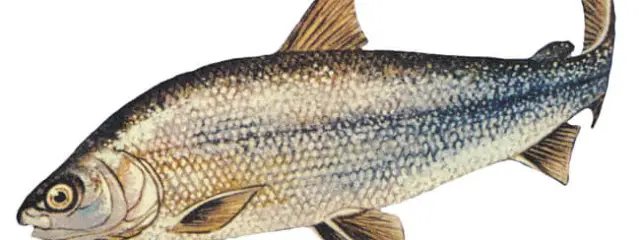The Lake Whitefish is a North American species of fish in the Salmonidae family. Their closest relatives include trout, salmon, grayling, char, and more. People refer to this species by a number of other names, including gizzard fish, common whitefish, Great Lakes whitefish, inland whitefish, and more. Read on to learn about the Lake Whitefish.
Description of the Lake Whitefish
This species has your typical “fish” appearance, with a torpedo-like body and silvery scales. Its dorsal fin sits midway down its broad body, giving it something of a hunchback appearance. On average, this fish measures about 20 in. long and weighs around 4 lbs. However, the largest individuals can reach lengths up to 31 in. and weights up to 15 lbs. or more!
Interesting Facts About the Lake Whitefish
This fish species has a number of interesting traits and adaptations. Read on to learn what makes it unique, below.
- Bottom Feeder – The mouth of this species faces slightly downward on its body. This placement makes it easy for the fish to forage along the bottom as well as near the top of the water.
- Ice Fishing – Because this species lives in cold, northern waterways it is a popular target in ice fishing. This sport holds particular popularity in Wisconsin.
- Lam-“prey” – This species, along with other whitefish species, often falls prey to the invasive sea lamprey. Researchers believe that these invasive creatures entered the Great Lakes through the building of the Erie Canal.
Habitat of the Lake Whitefish
These fish prefer cold habitats with access to deep waters. Most of the population lives in freshwater habitats, but some also occupy brackish water as well. They prefer lakes and large ponds, but they also live in rivers and streams. Populations migrate seasonally between deeper and shallower regions.
Distribution of the Lake Whitefish
This whitefish species lives in North America. It occupies cold northern regions in freshwater habitats. You can find it throughout Canada and Alaska into the northern United States. Its range includes all of the Great Lakes.
Diet of the Lake Whitefish
With a carnivorous diet, this fish feeds primarily on small invertebrates. Larger individuals also hunt for small fish. However, most of its diet consists of insects, insect larvae, fish larvae, fish eggs, small shrimp, and other invertebrates. They catch most of their prey along the bottom of the lake or pond.
Lake Whitefish and Human Interaction
Humans rely on this species for both commercial and recreational fishing. People eat their meat, and also eat their eggs as caviar. While overfishing once plummeted the populations of this fish, it has recovered with the implementation of fishery management. The IUCN currently has not evaluated this species.
Domestication
Humans have not domesticated this fish in any way.
Does the Lake Whitefish Make a Good Pet
No, this whitefish does not make a good pet. It grows quite large to keep in a home aquarium, and honestly does not have any interesting qualities as a pet.
Lake Whitefish Care
Some aquariums house schools of this species. Because they reach respectable sizes, they house the schools in relatively large enclosures with cold water that replicates their natural habitats. Aquariums often keep this fish with other similar species. Their diets typically contain fish, mysid shrimp, mollusks, crustaceans, and more.
Behavior of the Lake Whitefish
Populations of whitefish live in groups, known as schools. On a typical day, they swim slowly along the bottom in search of prey.
These schools migrate seasonally between shallow waters and deeper waters. In the spring, they swim into shallow water, return to deep water in summer, back to shallow in the fall to spawn, and back to deep in the winter.
Reproduction of the Lake Whitefish
Once a year these fish return to the shallows to spawn. During spawning, the females swim to the surface of the water and release their eggs. Simultaneously, the males release their sperm, known as “milt.” Fertilization occurs outside of the body.
Larger females contain more eggs, with as many as 130,000 or more in the heaviest females. After spawning, the adults leave and provide no parental care or protection of the eggs and young fry.





![Red Angus Closeup of a beautiful Red Angus cowPhoto by: U.S. Department of Agriculture [pubic domain]https://creativecommons.org/licenses/by/2.0/](https://animals.net/wp-content/uploads/2020/03/Red-Angus-4-238x178.jpg)












![Red Angus Closeup of a beautiful Red Angus cowPhoto by: U.S. Department of Agriculture [pubic domain]https://creativecommons.org/licenses/by/2.0/](https://animals.net/wp-content/uploads/2020/03/Red-Angus-4-100x75.jpg)

